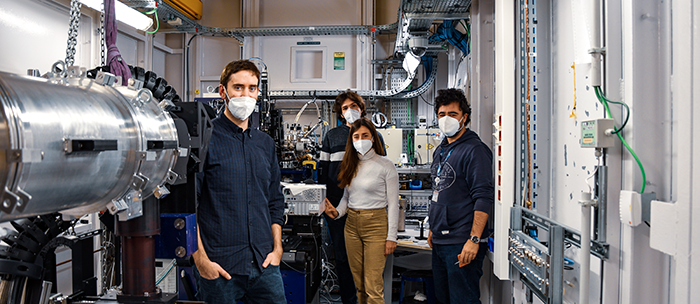
From left to right: Eduardo Solano scientist at the ALBA Synchrotron and Edgar Gutiérrez, Sara Marina and Nicolas Ramos, researchers from POLYMAT and the University of the Basque Country, inside the experimental hutch of the ALBA Synchrotron's NCD-SWEET beamline.
Cerdanyola del Vallès, December 16th, 2020. The prestigious scientific journal Advanced Materials published a paper presenting for the first time an experimental methodology that allows quantifying the composition of solar cells, a fundamental knowledge for the design of more efficient and stable devices.
This year, several examples of solar cells made with semiconductor plastics - which offer great advantages in economic, environmental and technological aspects - have reached efficiency photoconversion (sunlight into electrical energy) values of 18%, thus reaching figures that until recently were believed to be only achievable by inorganic solar cells.
Plastic solar cells are comprised, in fact, of two materials: a semiconductor polymer (plastic) and another electron-accepting compound. It has been known for years that, in order to obtain the maximum performance from the solar cell, it is necessary that both regions where the compounds are intermixed and regions where the materials are pure (not mixed) coexist. This is due to the fact that, when sunlight is absorbed into the solar cell, electrical charges are generated more efficiently in the intermixed regions, but pure regions are needed for these charges to reach the electrodes and, therefore, generate electric current. However, how intermixed or pure these regions have to be is something that remained unknown until now, since the necessary tools to measure this were not available.
The paper presents for the first time an experimental methodology based on nanocalorimetry, which makes it possible to quantify the composition - that is, the degree of intermixing - of the solar cells. The article highlights that, surprisingly, although a poorly mixed system is already capable of generating sufficient electrical charges, it does not allow adequate extraction of those charges and therefore the generation of current, since the transport of charges is only efficient in solar cells that include highly intermixed regions.
This knowledge is essential to establish quantitative relationships between the morphology and the efficiency of organic solar cells, thus allowing the design of even more efficient and stable devices.
Synchrotron light to validate results
Specifically, at the ALBA Synchrotron, experiments of Grazing Incidence Low Angle X-ray Scattering (GISAXS) were carried out at the NCD-SWEET beamline, helping to support the theory that in one of the two systems studied, the compounds are more mixed than in the other.
Eduardo Solano, the beamline scientist, explains that “what has been done at ALBA has been to verify the model. It is a clear example of laboratory method validation, since it is not always possible to have access to a synchrotron, and time is limited. "
The GISAXS technique has served to compare the different systems between them since, depending on the degree of mixing of the materials, the dispersion changes. Therefore, it provides a qualitative value that supports the quantitative results of calorimetry.
“This is a fairly easy technique to carry out. Done properly, it does not degrade the material and it is easy to prepare and measure. With the calorimetry, the idea was to obtain real numerical data, while X-rays give us a qualitative value." Explains Edgar Gutiérrez, a post-doctoral researcher at the UPV / EHU and one of the authors of the paper.
“What makes this technique even more interesting is that it allows us to see the material just as we would when depositing it in a solar cell. We often come to ALBA for the different projects we have and the information we are collecting is quite interesting”, adds Sara Marina, a Ph.D. student at the UPV / EHU and first author of the paper.
The team plans to carry out further measures at ALBA to study different materials that hold the record for efficiency in organic solar cells.
The research project that led to the publication was led by Jaime Martín, a researcher from the Polymers Group of the University of A Coruña (Spain); and had the collaboration of researchers from the University of the Basque Country (UPV / EHU, Spain), the Georgia Institute of Technology (USA), the University of California Santa Barbara (USA), the Imperial College London (UK), the Materials Physics Center (CSIC-UPV / EHU, Spain) and the ALBA Synchrotron.
Reference: Sara Marina, Noëmi Petrina Kaufmann, Akchheta Karki, Elizabeth Gutiérrez‐Meza, Edgar Gutiérrez‐Fernández, Joachim Vollbrecht, Eduardo Solano, Barnaby Walker, James H. Bannock, John de Mello, Carlos Silva, Thuc‐Quyen Nguyen, Daniele Cangialosi, Natalie Stingelin, Jaime Martín. The Importance of Quantifying the Composition of the Amorphous Intermixed Phase in Organic Solar Cells. Advanced Materials. 2020. DOI: https://doi.org/10.1002/adma.202005241




